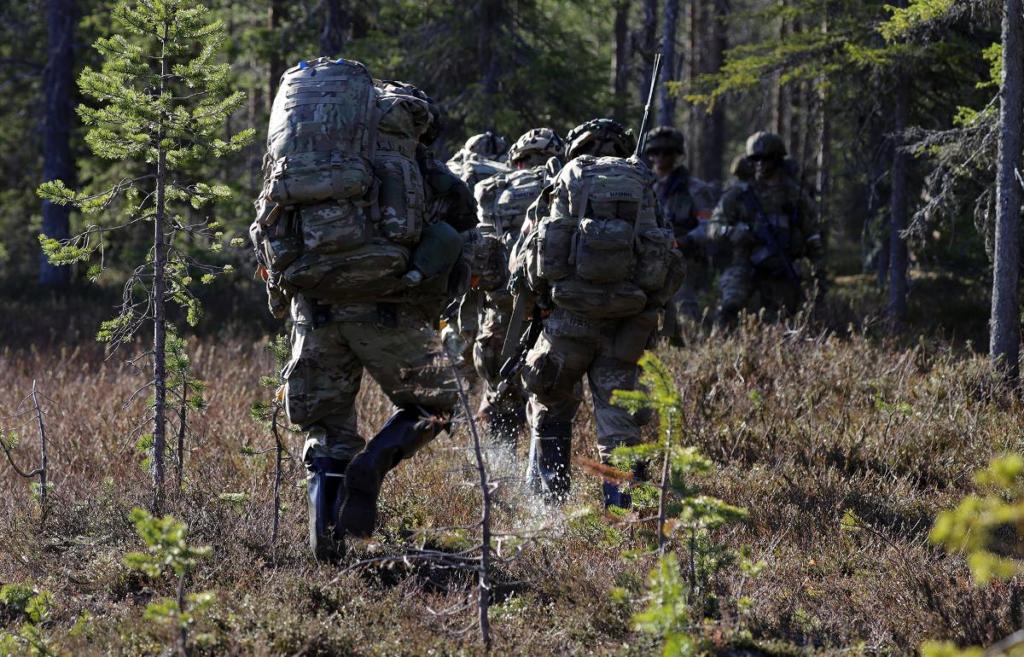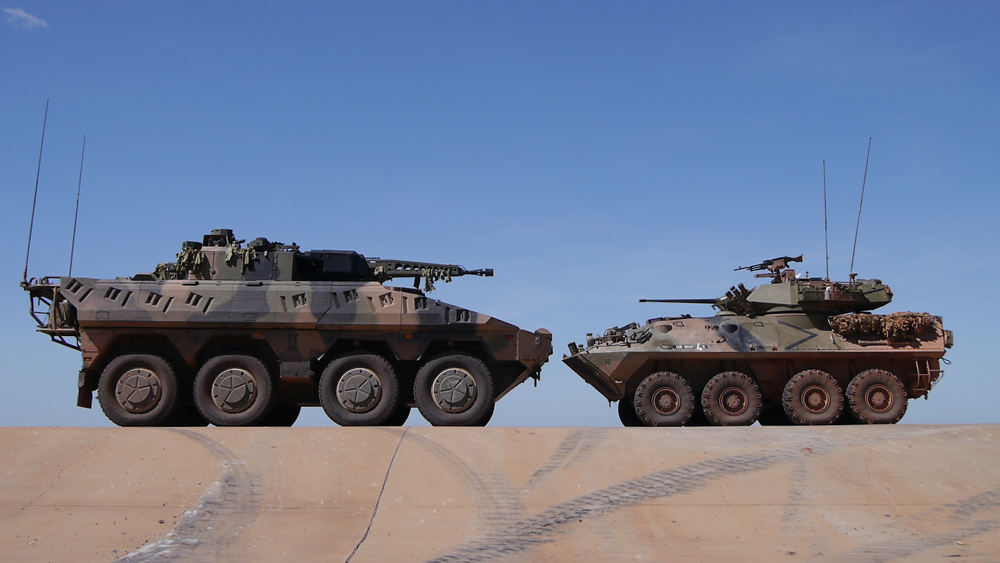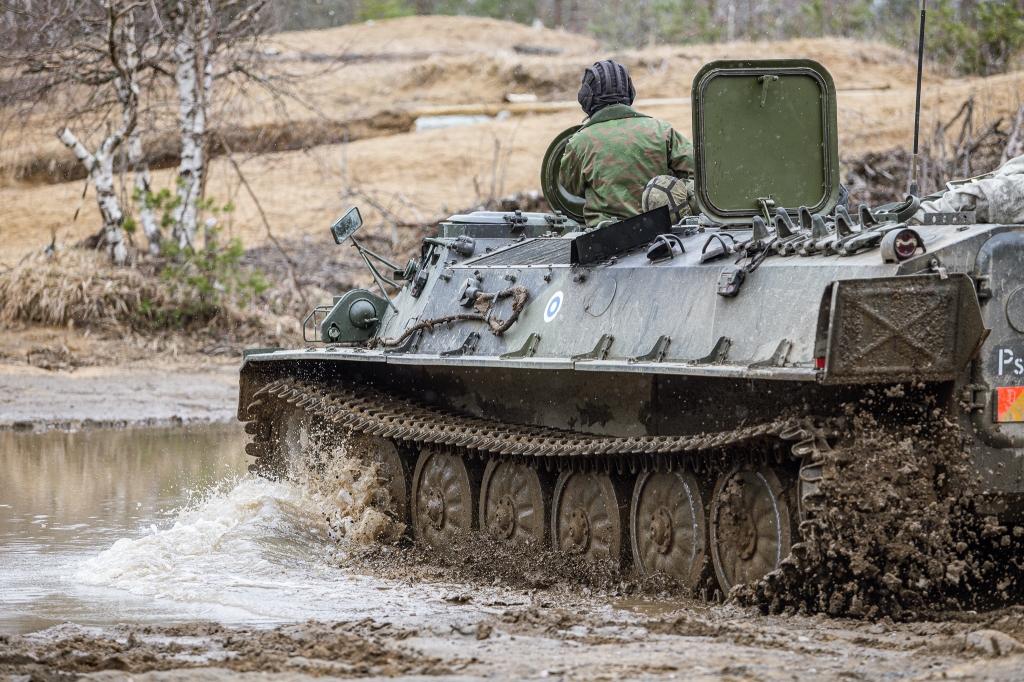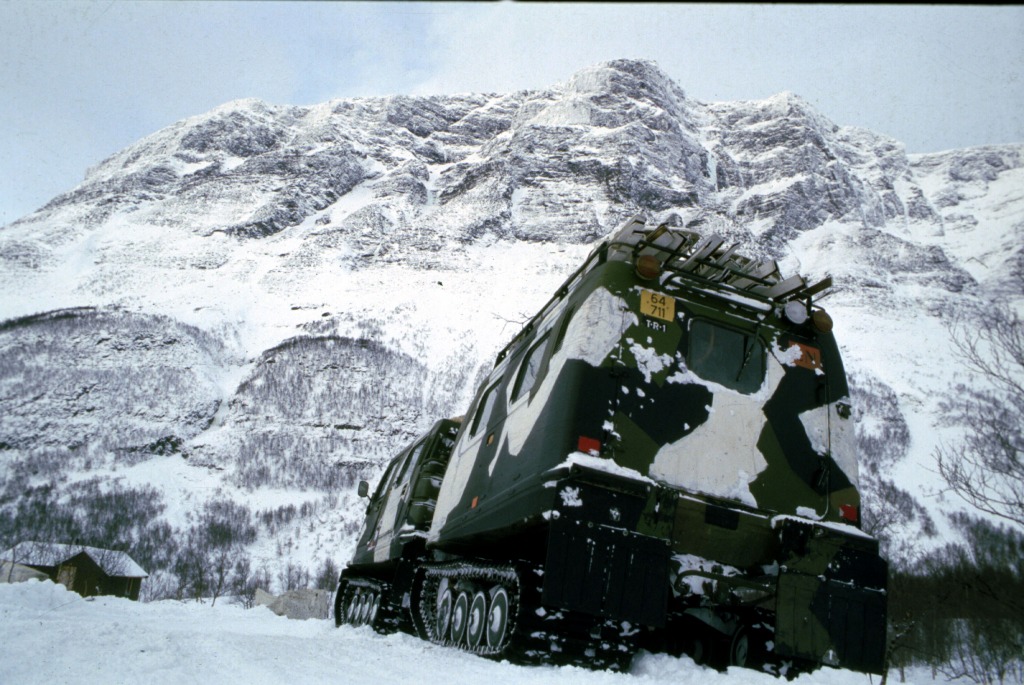During one of the lectures in my NCO-course the officer at the front of the room pulled up a slide which showed typical groupings of a Finnish infantry platoon on the move. What followed has stuck in my memory, because the slide showed two different setups – for wheeled APCs as well as for tracked all-terrain carriers. One of us students commented that the latter setup is quite rare. The officer, with only the slightest of smiles, thoughtfully said:
Well, they are limited to the Jaeger brigade and the Kainuu brigade, so they cover only half the country.
The answer might have been a bit tongue-in-cheek – while the two brigades might be responsible for half the country, they do not make up half the wartime troops of the FDF infantry – he certainly had a point. There are literally hundreds of tracked ATCs in the FDF, in essence doing all kinds of jobs trucks and APCs handle in southern units. This include transporting personnel and equipment, as well as towing heavier weaponry. The majority of the ATCs used by the FDF are the ubiquitous Hägglunds BV 206, but a smaller number is of the armoured BV 308 version, and the Sisu NA-series still remain in service in limited numbers (in particular in the form of the portée 120 mm mortar carrier). The BV 206 is still in many ways a sound vehicle, but many of the systems are outdated and plagued by obsolescence issues. There’s also no denying that placing an infantry squad inside a box of fiber-reinforced plastic no longer counts as adequate protection. The first issue can be mitigated relatively easily, but the second one is obviously more difficult as we are talking about structural issues. However, perhaps the biggest issue is that the vehicles are simply too slow on the road. 40 km/h surely beats walking, but for any kind of longer operational movement – e.g. just the road trip from Sodankylä to Sevettijärvi is over 300 km – you are soon looking at either a long road march or putting the ATCs on a flatbed and the people in a bus.
Nothing of this is new, the limitations of the current fleet has been recognised for quite a while. Back in 2004 the Finnish Defence Forces paid for two studies – from Patria-Hägglunds (the joint-venture responsible for development and production of the original AMOS) and Singapore Technologies Kinetics respectively – to look into the alternatives for a replacement that would also offer some basic protection from shrapnel and small arms. However, things really kicked off with the FAMOUS and later FAMOUS 2 programs under the the European Defence Industrial Development Programme (EDIDP), which aimed “to develop the next generation armoured vehicles and situational awareness system that enhance ground combat capabilities”. In Finland’s case, Patria was contracted to “develop arctic mobility by a project that seeks a replacement vehicle solution for the ageing and soon decommissioned all-terrain carrier fleet”, as the FDF described it in 2021. This included both a focus on increasing the road speed, as well as getting some level of protection. The resulting platform was unveiled at EUROSATORY this week.
There are no bonus points on offer for noticing the resemblance to another recent Patria-product, the rather successful wheeled Patria 6×6 / XA-300 which has sold well around the Baltic Sea. And indeed, Mikko Karppinen, Patria’s Senior Vice President responsible for Mission Capability, was happy to confirm the relation between the two platforms. Nothing that while the tracked system obviously will lead to a somewhat different external shape, in particular on the lower parts of the hull, much can remain the same. “The layout is very similar, with a truck-like cabin for the driver. The dimensions are also rather similar, and the interior is almost identical,” he explains in a phone call from Paris. Like the XA-300, the vehicle seats a driver and commander up front, with a 10-strong squad of dismounts in the back, and there’s a lot of parts that are interchangeable between the two vehicles. This includes everything from door handles to the windshields, all in the name of providing synergies both for production, but also when it comes to spares and maintenance.
The basic layout is quite a dramatic shift from the BV 206 with its two compartments and articulated steering. While the number of people carried does drop – the BV holds an impressive 16 in the form of driver and commander plus three dismounts up front, and a further eleven soldiers in the back – the seating comfort does increase with modern individual seats. While anyone having to reverse while towing something will likely appreciate the shift away from articulated steering, on the surface the conventional layout does seem to indicate a focus on more traditional APC performance and operational rather than the advertised tactical mobility in arctic conditions. However, that is something that Karppinen pushes back against.
The focus is on tactical mobility. That is extremely important. However, we need to be able to quickly get the vehicle to whatever location it is where that tactical mobility is needed, and that’s where the question of operational mobility comes in.

That tactical “arctic mobility” as the FDF described it – though Patria notes that it is really “arctic and mountain tactical and operational mobility” – is not just about being able to move in deep snow, but also about soft ground in general, something that isn’t uncommon in a country described as “the sixth country in the world when it comes to marsh area” in Wikipedia’s article on the topic, or as the PE coordinator of the aforementioned NCO-course answered a question about suitable footwear before sending us out on an orienteering task.
This is Kainuu. It is a bit difficult to create a course that doesn’t take you straight through a bog.
Granted, I did get a nice demonstration both of the truthfulness of his words and the ability of the BV 206 to handle the terrain later that day, as while running along a nice and flat BV-track through the forest, it was only once the whole track started swaying under my feet that I realised I was running on a thin layer of mosses and vegetation, suspended over a body of water the depth of which I did not know, and which I wasn’t overly keen on finding out.

For an armoured vehicle, the requirement to handle soft ground comes down to a number of key metrics, such as ground pressure and longitudinal distribution of mass. However, another key detail is the height of the hull above the ground, to avoid the vehicle sinking down until laying flat on its ‘stomach’, tracks spinning. Patria is confident that the ATV will meet these requirements, noting that despite the low profile of the vehicle – at around two meters it is in fact a tad lower than the BV 206 and almost half a meter lower than Hägglunds’ new BvS 10 – there is enough ground clearance to go around, and at a combat weight of 15 tons in the standard configuration the ground pressure is where it needs to be. All in all, the tactical mobility is described as “very close” to what the BV 206 offers. However, at 80 km/h road speed and with a 600 km unrefueled range, the vehicle will be able to go twice as far as the BV before needing to top up the fuel tanks, and it does so at double the road speed, all while offering ‘light APC’ levels of protection (STANAG 4569 levels M1/K1). Fully amphibious, 2 meter gap crossing ability, and capable of scaling a 60 % climb makes up the rest of the key performance metrics. At EUROSATORY, the vehicle was also shown sporting a Kongsberg RWS to provide some fighting capability, though the vehicle is designed more along the lines of being an affordable APC for difficult terrain rather than being an infantry fighting vehicle. The low height is indeed a key feature. The height of combat vehicles have tended to grow with the latest generation, something that certainly helps with ergonomics for those aboard, but also creating a much larger target. As such, the low profile of the vehicle adds an amount of protection that isn’t evident from just looking at STANAGs (‘Don’t be seen’ and ‘Don’t be hit’ are after all two of the layers of the protection onion), in particular against traditional ground-level threats.

However, FAMOUS isn’t the only game in town. With Sweden as the lead nation, Germany, the Netherlands, and the UK have all teamed up under the Collaborative All-Terrain Vehicle program to acquire a successor for their BV 206 – with the three ‘minor’ users (compared to Sweden, that is) mainly using their BVs in specialised troops such as marines and mountain units. Under the ‘Why change a winning concept?’-tag line, the program saw a first order on roughly 400 MEUR for 436 BvS 10 going to Sweden (236), Germany (140), and the UK (60) back in 2022. The BvS 10 is larger (5.5 tons payload capacity), faster (70 km/h road speed), and armoured (with add-on offering protection up to 14.5 mm) compared to the BV 206 (2.4 t, 40 km/h, just ‘No’). However, more orders can be expected, as the need for new vehicles is significant, something that is evident by a Swedish lifetime extension program for their BV 206-fleet which last year saw an order for the re-engining and fitting of new transmissions to 800 BV 206/206D (the latter being referred to as Bv 208 in Sweden) with an option for a further 250 vehicles.

The difference in approach is rather interesting, with the BvS 10 on paper looking like the more specialised platform but also the one closer to the current platform. However, that might also be part of the answer to why the Finnish program looks like it does, because the BV 206 is far from the only ageing tracked platform in Finnish service.
Enter the Ällitälli, as it is affectionally known among generations of Finnish conscripts.

The MT-LBV (and closely related but slightly larger MT-LBu) is the armoured embodiment of Soviet design philosophy. Rugged, cheap, and not really living up to today’s standards. For those interested, I can highly recommend running this article through Google Translate, where the vehicle is described using phrases such as “11 soldiers can be carried in the 1.15 m high compartment in the rear, where they sit on fuel tanks acting as seats”, “From the back, you can get to the front compartment by going past the engine on the left side of the vehicle, but it requires agility and claustrophobia can strikesuddenly”, and “MT-LB is in principle amphibious, but only barely.”
Still, the vehicle is found in significant numbers in the force, and its general usefulness when it comes to both towing and carrying soldiers and equipment as well as significant numbers of specialised vehicles built on the basic platform means that it continues to play a key role in both mechanised and motorised units in the Finnish Army. And the fact is that suitable replacements have been difficult to find on an international market dominated by ever larger and better protected (and more expensive) wheeled platforms. The same has been the case for the M113 and other comparable western designs, where a surprising number has served on despite the age of the platform starting to show.
Could the FAMOUS ATV be the natural successor to the large numbers of MT-LB and M113 vehicles found in Europe (and further abroad) as well? On paper, it does fill the same capability gap, providing a light and relatively inexpensive tracked vehicle that could move stuff to and around on the battlefield with a minimum acceptable amount of protection. The big question is of course whether there still is a demand for that role? The UK as an example doesn’t seem to think so, as they are switching several traditional tracked roles to wheels, while those still needing tracks are going down the BvS 10-route. However, for a number of countries, including Finland, I would certainly argue the need still is there. As discussed the geography is such that, even with the huge advances in wheeled mobility in tough terrain we have seen in the last decades, tracks simply remain the better option (and tracks certainly has seen developments as well, such as the rubber tracks used by the FAMOUS ATV to keep weight down). In addition, while everyone would like to ride in battle in the best and brightest IFV with protection against anything and everything and with enough firepower to destroy the Death Star, the budgetary realities in those countries that need large ground forces relative to their size means that will never be the case for the majority of the troops (recent comments by Lt Gen Heiskanen that on mobilisation “There’s a rifle, enough rounds for it, a uniform, some kind of a helmet, and rubber boots for everyone” but that in the year of the Lord 2024 you might get a steel helmet and webbing M62 should put to rest any ideas about only buying AMVs and CV 90s for transports).

As such, while the basic requirement is centered around the demands placed by the bogs and snow of the High North and mountains, the platform coming out of it certainly has wider use as well in a world that has awoken to the fact that it isn’t about quantity or quality, but about the fact that you need both on the modern battlefield. Norway – a key Finnish ally in the North, prolific BV 206-user, currently rapidly expanding its ground forces, and stakeholder in Patria through Kongsberg’s 49.9 % share of the company – would not be a surprise customer just to name one. In addition there are M113 users within NATO with more than a hundred vehicles each in such varied locations as Portugal, Lithuania, and Greece, to give a few examples, and with Bulgaria in turn having a sizeable fleet of MT-LB versions in both active service and storage. For now the FAMOUS ATV is just a concept vehicle, but the plan at Patria is that once the trial period is over in 2026, by 2027 the company should be ready to start series production. Considering the usual answer when discussing the lifespan of BV 206-fleets regardless of which country we are dealing with usually includes the phrase “2030”, I would not be surprised if the factory will have to gear up for quite significant orders by then if the trials goes according to plan.
Fame might make you live forever, but FAMOUS might be what kills the MT-LB in Finnish service.


